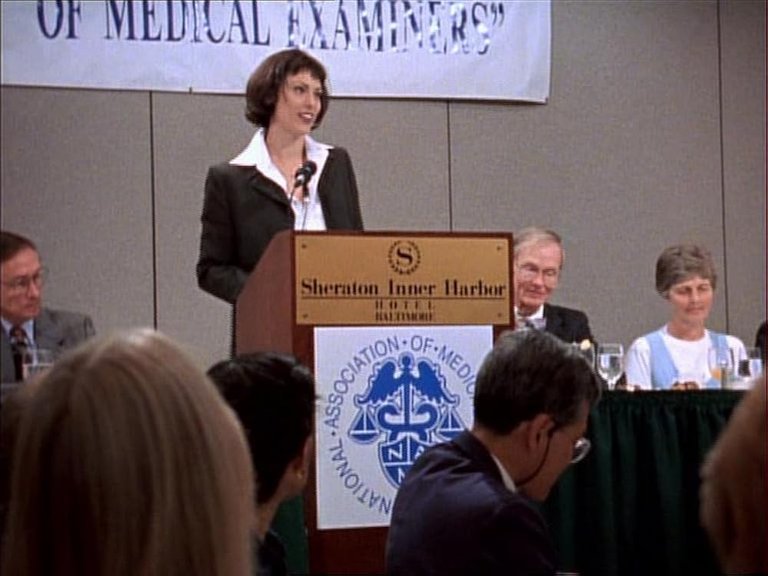Television Review: Shaggy Dog, City Goat (Homicide: Life on the Street, S6X11, 1998)

Shaggy Dog, City Goat (S06E11)
Airdate: 16 January 1998
Written by: Eric Overmyer
Directed by: Kyle Secor
Running Time: 45 minutes
In its early seasons, Homicide: Life on the Street distinguished itself from contemporaneous police procedurals through its unflinching commitment to gritty, unvarnished realism. The show’s creators drew heavily from the experiences of real-life homicide detectives, crafting narratives that prioritised procedural detail, moral ambiguity, and the raw textures of urban life in Baltimore. By refusing to sanitise crime or romanticise police work, the series carved out a unique identity, resisting the glossy, formulaic conventions of shows like NYPD Blue or Law & Order. However, by its later seasons, particularly the sixth and final run, the pressure to maintain ratings led to compromises that diluted this ethos. The show increasingly embraced melodrama, sensationalism, and contrived plotlines, trading its hard-earned credibility for more flashy, crowd-pleasing theatrics. Nowhere is this shift more evident than in Shaggy Dog, City Goat, an episode whose premise hinges not on the grime of reality but on an urban legend so outlandish it feels more at home in a CSI episode than in the grimy corridors of the Baltimore PD.
The episode opens with Dr. Julianna Cox, the medical examiner, finally given a moment of narrative prominence. Attending a conference in Baltimore, she receives an award before entertaining colleagues with a peculiar case: the apparent suicide of a man who fell from a building’s roof. Yet Cox’s scrutiny reveals inconsistencies—the victim’s body bears shotgun-shell wounds sustained during his fall, raising questions about whether the death was suicide, homicide, or an accident. Detectives Kellerman and Munch delve into the mystery, zeroing in on George and Emily Cochran, an eccentric elderly couple with a penchant for bizarre games involving their shotgun. The investigation uncovers tampering with the weapon and ammunition, suggesting a calculated plot. Cox’s breakthrough comes when she links fingerprints to an unidentified deceased man, revealing the victim’s estranged son orchestrated the death to spite his parents. The resolution hinges on a clever forensic twist, but the setup—a scenario so improbable it borders on farce—undermines the episode’s credibility.
The episode’s central premise is fascinating yet deeply problematic. While the shotgun-and-fall scenario might captivate audiences, it derives not from real-life crime but from a fictionalised “Roland Opus” story invented in 1987 by forensic pathologist Don Harper Mills as a training exercise to distinguish suicide, homicide, and accident. Though this fictional tale later entered pop culture as an alleged true story—most notably in the prologue of Magnolia—its inclusion here feels jarringly out of place. Homicide had always prided itself on authenticity; the show’s creators often embedded real-life cases into scripts, ensuring even minor details resonated with lived experience. By contrast, Shaggy Dog, City Goat leans into sensationalism, relying on a premise that prioritises shock value over plausibility. The casting of early television legends Steve Allen and Jayne Meadows as the Cochrans—a meta-nod to their real-life marriage—adds a quaint, nostalgic charm, but the joke is lost on all but the oldest viewers. This episode’s reliance on fictional lore places it closer to the flashy, hyper-stylised crime dramas of the 2000s like CSI than to the grounded ethos of Homicide’s early seasons.
The episode’s chief flaw is its lack of focus. While the Cochran subplot offers moments of intrigue, it is bogged down by competing storylines that dilute its impact. One subplot shifts to Detectives Ballard and Gharty investigating the killing of a black drug dealer who cheated customers with adulterated product. The detectives trace the suspects to rural Allegheny County, an excursion outside their jurisdiction that ends in farcical failure. Ballard’s confrontation with the “white trash” McCord brothers—a clichéd portrayal of Appalachian poverty—feels tacked-on, its socioeconomic commentary undercut by the episode’s broader tonal inconsistencies. Similarly, the decision to frame the investigation as a clash between Ballard's urban sophistication and rural squalor reduces complex class dynamics to a simplistic “Third World” analogy, diminishing the narrative’s weight.
The episode further suffers from the weight of prolonged, underdeveloped arcs. Falsone’s custody battle and Georgina Rae Mahoney’s vendetta against the detectives linger as unresolved threads, their inclusion here feeling perfunctory rather than purposeful. When Lewis confronts Georgina over her wrongful-death lawsuit, the scene devolves into physical altercations and suspensions, a plot point that Lt. Giardello endorses despite his usual protectiveness toward his team. These subplots, though indicative of the show’s broader narrative sprawl, feel shoehorned in, their emotional stakes neutered by the episode’s fractured focus.
Directed by Kyle Secor, a regular cast member whose work on the show was consistently strong, Shaggy Dog, City Goat possesses moments of technical proficiency and sharp performances. Cox’s forensic brilliance, the eerie atmosphere of the Cochrans’ home, and the cast’s chemistry elevate scenes that might otherwise falter. Yet these strengths are overshadowed by the episode’s structural and tonal flaws. The juxtaposition of the Cochran mystery—a gleaming, almost fantastical puzzle—with the grubbier, more grounded subplots creates a dissonant clash of tones. While the urban-legend premise might have worked in a self-contained anthology series, it feels alien within Homicide’s established framework. Ultimately, the episode epitomises the show’s later seasons: a series still capable of flashes of brilliance, but hamstrung by its quest for ratings-driven spectacle. The loss of its original vision is palpable, leaving viewers to wonder what might have been had the creators resisted the siren call of melodrama.
RATING: 5/10 (++)
Blog in Croatian https://draxblog.com
Blog in English https://draxreview.wordpress.com/
InLeo blog https://inleo.io/@drax.leo
Hiveonboard: https://hiveonboard.com?ref=drax
Rising Star game: https://www.risingstargame.com?referrer=drax
1Inch: https://1inch.exchange/#/r/0x83823d8CCB74F828148258BB4457642124b1328e
BTC donations: 1EWxiMiP6iiG9rger3NuUSd6HByaxQWafG
ETH donations: 0xB305F144323b99e6f8b1d66f5D7DE78B498C32A7
BCH donations: qpvxw0jax79lhmvlgcldkzpqanf03r9cjv8y6gtmk9